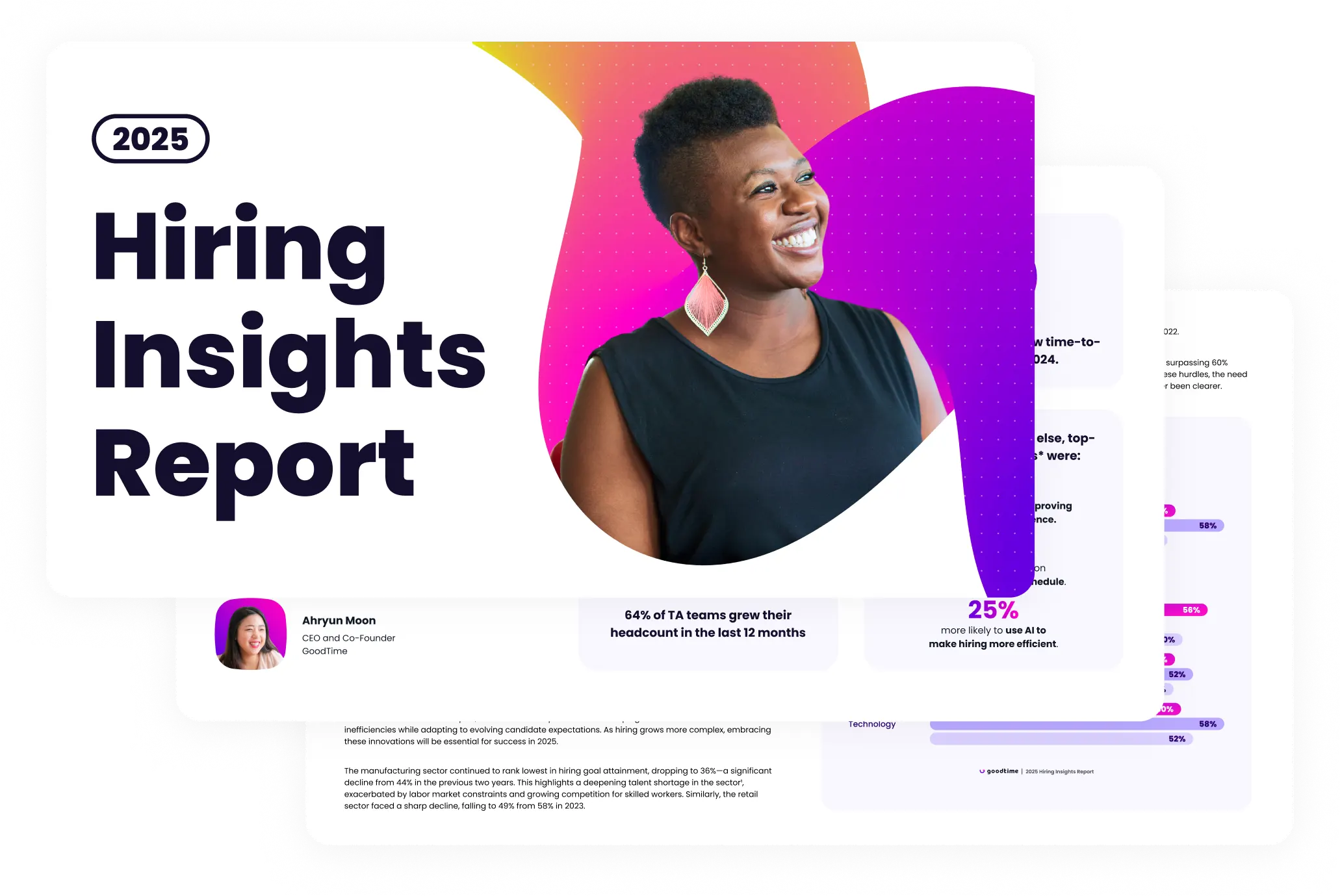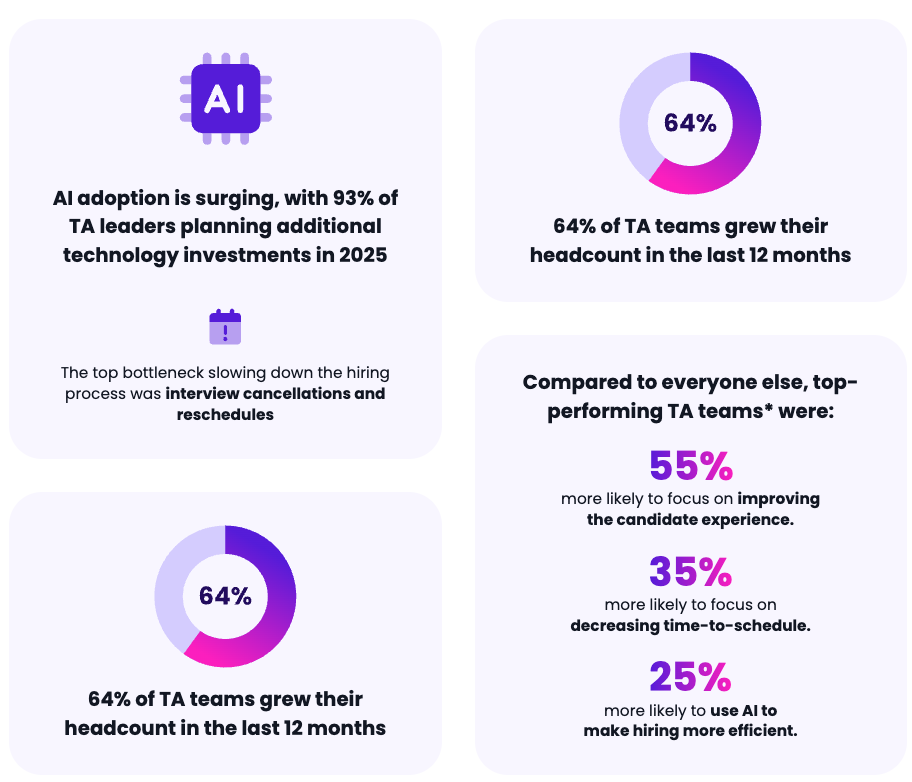In 2025, hiring is about so much more than filling open roles—it’s about creating the exceptional hiring experiences that continuously grow a world-class workforce.
We surveyed over 500 TA, HR, and recruitment leaders to get the real scoop on what’s working and what’s not. You can find all of our findings and the experts’ advice in the 2025 Hiring Insights Report, but in case you’re short on time, I’ve got the seven of 2025’s talent acquisition trends that you can’t miss if you want to hit hiring goals in the coming year.

Unlock 2025’s top hiring strategies: Insights from 500+ TA leaders
Be the first to uncover deep hiring insights specific to your sector — straight from the highest-performing TA teams.

Key trends at a glance

1. AI adoption is surging, with 93% of TA leaders planning additional technology investments in 2025

99% of the leaders we surveyed said their teams used some form of automation or AI in the past 12 months. And most did so with the goal of limiting ‘administrivia’, as Jonathon Wall calls it. Jonathon is the Founder of Cassillon.AI and a seasoned recruiting leader with over two decades of experience. More recently, he has focused on helping companies use automation and AI to hit their goals.
“We should be leveraging automation and AI to do those things that aren’t fun,” he tells us. “Recruiting is a very defined process and a lot of what I call ‘administrivia,’ it’s the stuff that recruiters don’t like… They kind of keep us from doing the things that really are our superpowers. We’re people people. The message I would give is to leverage all of those tools so that you can have higher-quality human interactions.”
2. Tech investment leads to higher goal achievement
For our report, we analyzed top-performing TA teams — those who hit 75% or more of their hiring goals over the last 12 months — to see what they did differently and what their focus areas are for 2024.

Compared to everyone else, the highest-achieving recruitment teams were 40% more likely to focus on upgrading their hiring technology.
Drilling into specific tech, top performers were:
- 28% more likely to adopt automated, candidate-driven interview scheduling
- 25% more likely to use AI-powered interview scheduling tools
- 28% more likely to use AI-powered analytics and reporting
3. Texting candidates the right way
In 2023, nearly every company reported that their talent aquisition teams embraced text recruiting in the past year.
And most companies (52%) are doing so through a centralized platform or text recruiting software. That’s good news because when recruiters text candidates from personal cell phones, or even from a company-provided phone, major compliance risks and process inefficiencies enter the chat.
Risks of texting candidates with a phone instead of a centralized platform:
- Lack of visibility: You can’t see what your recruiters are communicating to candidates.
- Non-standardization: Going off-script and outside of company systems leads to disconnected, inconsistent candidate experiences.
- Inefficient handoff: If a recruiter has something come up or takes time off, there’s no way for someone else on the TA team to seamlessly pick up the conversation with a candidate.
- Security and compliance risks: Personal phone use leaves organizations more vulnerable to data breaches, unauthorized access to sensitive information, and noncompliance with laws regulating unsolicited text messages.
4. The end of manual interview scheduling
As of the end of 2023, over half (51%) of companies were automating interview scheduling, contributing to the significant reduction we saw in the amount of time recruitment teams spent scheduling this year (from 42% in 2022 to 35% in 2023).
Let’s examine this talent acquisition trend against data from our platform, GoodTime, which automates all aspects of interview scheduling, from candidate communication and availability collection to new interviewer training, performance tracking, and reporting.
GoodTime users taking advantage of the platform’s auto confirm feature achieved an average time-to-schedule of just six days in 2023, which helped them realize an up to 86% reduction in time spent scheduling and a 50% reduction in time-to-hire.
And that time savings can make a major impact on a team’s ability to achieve their goals.
TA teams that automated interview scheduling saw a 13% lift in hiring goal attainment in 2023 versus those that didn’t.
Talent retention broke out far and away as the top hiring challenge of 2023, cited by 34% of TA leaders. With 24% also observing a shortage of qualified candidates, the opportunity cost of replacing employees rises significantly. Not only must organizations invest more to recruit and train new hires, but they also face the added challenge of sourcing candidates who can meet the increasingly complex demands of today’s roles.
But to what extent are TA leaders actually responsible for employee retention? Manjuri Sinha, Global Director of Talent Success & DEI at OLX, thinks TA leaders absolutely share in that responsibility, as it starts with being authentic and realistic in the hiring process.
“I think selling great things about an organization just to get that hire — those days are gone. Today, we have to be really realistic about things,” she tells us. “People would ask you questions or say, ‘We heard last year you had 15 percent layoffs.’ If that’s the case, be very honest about it.”
In addition, she says TA teams can bolster talent retention by making sure to hire the right managers, who have a major influence on the employee experience. In the current high-pressure market, she says it’s also key to prioritize candidates who can clearly demonstrate adaptability and resilience.
6. Measuring quality of hire
The only way TA teams can know if they are hitting their goals is if they’re measuring their performance properly. We asked which recruitment metrics they’ve got their eye on in 2024.
Far and away, quality of hire was the most important, with a quarter of companies saying it’s their number one performance metric. And while surely every TA leader would say that quality of hire is important, it’s not as straightforward to measure as, say, application completion rate.
So how do you measure quality of hire? Craig Pyke, Director of Talent Acquisition at Rivian, recommends starting simple with data you already have: “You can look at attrition within the first 90 days as one indicator of quality of hire,” he shares. “And when you combine exit survey data of why that they’re leaving with the factor of them attriting within 90 days, you can really start to pinpoint if that’s a TA challenge or if that’s a challenge somewhere within the business. That’s super, super important.”
We like that Craig’s approach measures quality of hire as a function of talent retention, addressing the top challenge TA leaders pointed to in 2023. After all, the right hires will certainly stick around past their probationary period, and the wrong hires will churn and leave your team back at square one.
But what about the other metrics? Skyla Lambeth, Recruiting Operations Manager for Collective Health, laid out a simple starting point to help reveal efficiency gaps from your current data: “It’s crucial to monitor time-to-hire data. Pay close attention to pass-through rates, understanding how many candidates are required at the top of the funnel to make a job offer. Additionally, it’s vital to assess how many candidates successfully progress from the on-site stage or panel interview, especially when multiple people are involved in the interview process.”
7. Candidates are still king
One thing leaders from every sector (mostly) agreed on: The hiring landscape will become even more competitive in 2024 and candidate experience will become increasingly important.
To create a candidate experience that lands top talent in 2024, TA teams think they’ll need to focus on:
- Quickly connecting with candidates (46%)
- Spending more time building meaningful relationships with candidates (45%)
- Increasing the number of candidate touchpoints in their process (42%)
And all of this needs to be done with leaner teams, with 45% anticipating challenges due to recruitment team turnover. Providing a stellar, but sustainable candidate experience requires focusing on the highest-value perks and touchpoints you can offer — the ones that will make a huge difference for candidates, but won’t wear heavily on your recruiting team’s limited resources.
“I would challenge every recruiter to apply to a job on their website and then apply to a job on their competitor’s website. Just spend the time going through and understand what your process is already and you will immediately find ways to improve your candidate experience.”
Amanda Richardson, CEO and Head of People | CoderPad
Another way to ensure you’re making the most of your team? Establishing a reliable and realistic recruiter capacity model.
Use these trends to win top talent in 2025

So how do we put these talent acquisition trends into action? Of course, it will depend on the needs of your specific organization, but you can’t go wrong with a dual approach of embracing new tech and optimizing your processes. Here are three key themes to put on sticky notes:
- Embrace automation and tech to hit more of your hiring goals. Top-performing TA teams were 40% more likely to focus on upgrading hiring technology.
- Renew your commitment to understanding candidates — and addressing their evolving preferences and needs.
- Take it back to basics and enforce standardized processes to support efficiency efforts as well as eliminate unconscious biases.




